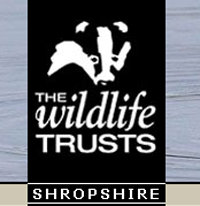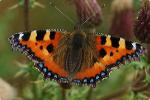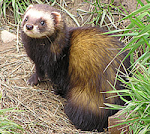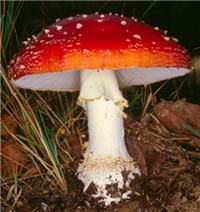Wednesday 17th August 2022, Pennerley Permaculture
A chance meeting last year led to an invitation to survey this site. It consists of a garden, forest garden, grassland and a couple of small woodlands. It is situated on the foothills on the western face of the Stiperstones.
.jpg) |
| Photograph: Bob Kemp |
We met in a layby close to the site where we were met by one of the owners. We were taken to the site and given a brief introduction to the site and its facilities.
 |
| Photograph: Jim Almond |
I shall get the weather out of the way now and have done with it.
It had rained overnight and continued to drizzle on and off for the rest of the day, including a short spell of heavy rain. After the previous week’s experience we should have been ecstatic, but the wet conditions and long grass did not make it easy to find invertebrates. (Nor for photographers who, very reasonably, did not want to get their equipment wet.)
We spent the morning in the garden, forest garden and associated grassland area.
Unfortunately very little was stirring and keeping well out of the way of our nets and trays. We persevered. However it was just as interesting to wander around the area trying to work out what the trees and plants were.
Looking under the bark of a log we discovered a Common Lizard trying to keep out of the way.
 |
| Photograph: Jim Almond |
A large moth that did put in an appearance and hung around long enough to be photographed was a Shaded broad-bar.
 |
| Photograph: David Williams |
We were able to find some flies that had ventured forth to brave the conditions:
A hoverfly, Episyrphus balteatus;
 |
| Photograph: Jim Almond |
A Yellow dung fly;
 |
| Photograph: Jim Almond |
And a second hoverfly, Rhingia campestris.
 |
| Photograph: Jim Almond |
I was just about to enter the meadow next door.
When I noticed that time, as always, had marched on and it was that time of the day to take lunch.
One of the facilities of the site was a room that we could use for lunch. This was very welcome in view of the very wet conditions and intermittent rain.
We made our way there at a leisurely pace, in case anything of interest might be seen on the way.
The room was magnificent. Seats for all, sink, kettle with some tea, coffee and milk and a toilet,. All these were made use of.
The end of lunch coincided with a burst of heavy rain.
Did this stop us from continuing.
No!
But we were, perhaps, not quite as keen as we would have been had the sun been shining.
Early finds after lunch were:
A couple of flies that we have not been able to identify;
 |
| Photograph: Jim Almond |
 |
| Photograph: Jim Almond |
A further hoverfly, Eristalis arbustorum;
 |
| Photograph: Jim Almond |
And a mirid bug, a Lygus species, its appearance suggests Lygus wagneri but it cannot be identified from the photograph as you need to inspect the structure of the wing to confirm which of five similar species it is.
 |
| Photograph: Jim Almond |
We made our way to the meadow that we had abandoned for lunch.
.jpg) |
| Photograph: Bob Kemp |
And while we are up in the air here is the view from that meadow.
 |
| Photograph: Bob kemp |
Not that you would know it from ground level!
Close to the meadow entrance we found a Comma butterfly larva on a nettle.
 |
| Photograph: David Williams |
Moving into the meadow a nymph of a Sloe bug (or Hairy shieldbug if you prefer, Dolycoris baccarum for the purists) was spotted on a seed head.
 |
| Photograph: David Williams |
Knapweed was fairly abundant. A mirid bug often found on this plant at this time of year is Oncotylus viridiflavus.
 |
| Photograph: David Williams |
There were also a few small patches of broom and we found a beetle associated with this plant, which we have been informed is Gonioctena olivaceae.
.jpg) |
| Photograph: David Williams |
Unfortunately I was finding it difficult to move around the sloping meadow so I left to go back to the garden area to see what else I could find in there. Some joined me, others pressed on with searching in the meadow.
On the way to the garden area we passed a post with a fine collection of Cladonia lichen growing on the top.
Back where we had started, a vacuum sample of the grassland discovered the larva of an Orange ladybird.
 |
| Photograph: David Williams |
Together with an inconspicuous ladybird, Scymnus haemorrhoidalis.
 |
| Photograph: David Williams |
I wonder, why it is called haemorrhoidalis?
Several specimens of another orange beetle were found. We decided that it may be Chrysolina staphylaea. To allay this uncertainty a photograph was taken and sent to a local expert for confirmation.
.jpg) |
| Photograph: David Williams |
By now it was time to leave. As we went I noticed this tucked away:
I was alone.
I heard others on the other side of the hedge.
“Do you know what this large thistle-like plant is?” I called out, hopefully.
“Cardoon” came the reply without looking.
Clearly they had seen it earlier in the day!
In one of the photographs above you may have noticed a chimney in the middle distance. This is part of Tankerville Mine.
As the mine borders the site a few of us took advantage of this proximity to take a look.
.jpg) |
| Photograph: Bob Kemp |
Information about the site can be found on the Shropshire Mines Trust website.
And here is what you can do to a photograph of a similar view with some imagination and the right software.
.jpg) |
| Photograph: Bob Kemp |
There was another visitor to the mine whilst I was there.
A Green-veined white. At least when the weather is cool and damp they do not fly away as you get near, allowing you to take a good look!
My thanks to the owners of the site and their neighbours for allowing us to do what we enjoy doing and providing the room and refreshment for lunch. My gratitude to the photographers for providing their excellent images.
.JPG)
.JPG)


.JPG)
.JPG)



























No comments:
Post a Comment
Please feel free to comment on this post...